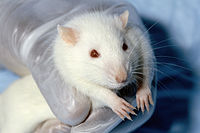
Photo from wikipedia
eBioMedicine 2022;76: 103900 https://doi.org/10.1016/j. ebiom.2022.103900 On Dec 3, 2021, The Francis Crick Institute issued a press release titled “Gene editing used to create singlesex mouse litters”, describing the ability of… Click to show full abstract
eBioMedicine 2022;76: 103900 https://doi.org/10.1016/j. ebiom.2022.103900 On Dec 3, 2021, The Francis Crick Institute issued a press release titled “Gene editing used to create singlesex mouse litters”, describing the ability of scientists to generate all-male or all-female mice with 100% efficiency. At first glance, this might be construed as another example of humans playing God. However, the significance of this technology, as described in Nature Communications, has far-reaching implications relating to the way scientific research and agriculture is conducted. According to James Turner, one of the corresponding authors of the paper, at least 25 000 publications in the past 5 years have used mice in sexspecific research studies. Multiple reasons might explain this preference, such as the study of particular cancers, sex-specific hormones, or reproductive tissues. The farming industry has similar biases, including hens for eggs, cows for milk, and boars for pork, resulting in the culling of a vast number of animals that are considered to be an undesirable sex. These practices are inefficient and ethically questionable, and strategies like this gene editing approach represent a potential means to mitigate such waste. The use of animals in scientific research is guided by the principles of the 3Rs (replacement, reduction, and refinement), first described in 1959 by WMS Russell and RL Burch in a publication called The Principles of Humane Experimental Technique. The goal of the 3Rs is to find alternatives to animal testing (replacement), to optimise the amount of information obtained from fewer animals (reduction), and to adopt methods that alleviate distress (refinement). These guiding principles aim to improve both the quality of the science and animal welfare, when the use of animals is unavoidable, and has been adopted by many countries who ensure the 3Rs have been fully considered when conducting animal research. The 3Rs are not a static set of directives and the technological developments that fuel scientific progress also stimulate innovations in the way the 3Rs are accomplished. For example, the development of new cell culture strategies has facilitated the partial replacement of animals in research and eBiomedicine has published articles on lab-on-chip technology (eg, a microfluidic device to model lymphatic vessels in head and neck cancer), and the tractable use of organoids to model a variety of tissues (eg, pancreatic cancer and irritable bowel disease). The full replacement of animals has been achieved by improving the in vivo culture methods of primary human cells (eg, a recent review article on culture developments in cystic fibrosis research), maximising the information that can be obtained from patient biopsies (eg, by applying metagenomic Next-generation
Journal Title: EBioMedicine
Year Published: 2022
Link to full text (if available)
Share on Social Media: Sign Up to like & get
recommendations!